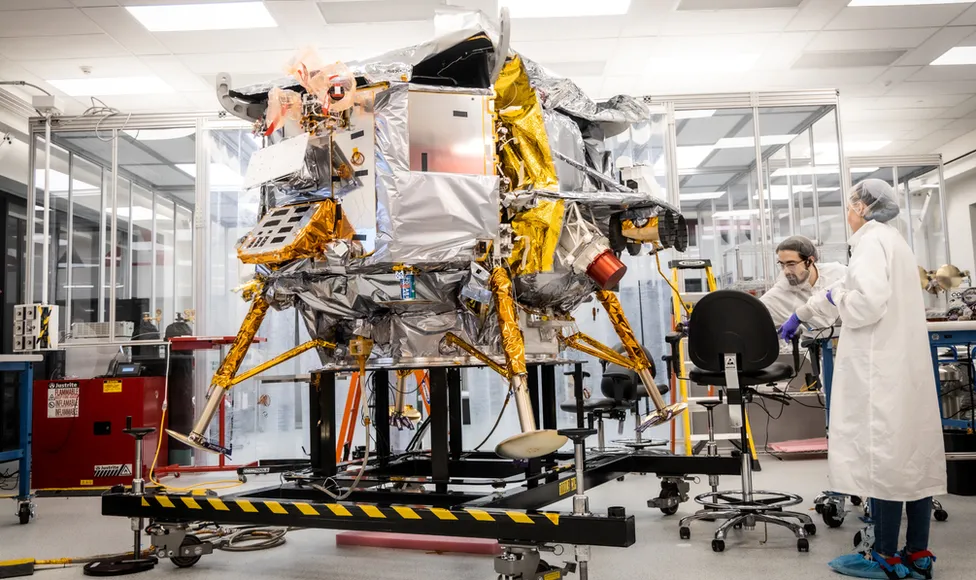An US spacecraft has launched from Cape Canaveral, Florida, to try to perform a controlled landing on the Moon.
It's aiming to become the first American mission in 51 years to complete a soft touch-down, and the first ever by a private company. Astrobotic's robotic lander, called Peregrine, has been contracted by Nasa to carry five scientific instruments.
These will study the Moon's surface environment ahead of human missions later this decade. Peregrine is part of a stampede of spacecraft that will attempt to put themselves on the lunar surface in 2024 – possibly as many as eight different projects, including from Japan and China.
Astrobotic's venture was sent on its way by a brand new rocket called Vulcan, which left its Florida pad at 02:18 EST (07:18 GMT). Fifty minutes later, after a flawless flight, the Pittsburgh-based company's craft was ejected on a path to the Moon.
It will take a few weeks to get itself into position to attempt the touch-down.
The planned 23 February descent will target a smooth lava plain on the Moon's near-side known as Sinus Viscositatis, or “Bay of Stickiness” – a reference to the type of volcanic material that may have built nearby hills.
Not since the last Apollo mission in 1972 has there been any US effort to place a spacecraft gently on the lunar surface – although US probes have been deliberately crashed into the Moon for one reason or another in the meantime.
Running surface operations is back on the agenda because Nasa wishes soon to resume astronaut missions, and it is going to use robots from commercial partners to deliver scientific instrumentation, general equipment and supplies – a move the agency believes will work to reduce costs over time.
Astrobotic is the first of three US companies to send a lander under this new arrangement. Two other companies, Intuitive Machines and Firefly, will follow in the coming months.
Indeed, it's possible Houston-based Intuitive Machines may even beat Astrobotic to the surface because although its lander is not due to launch until mid-February, it's taking a quicker route to the Moon.

All three US companies have Nasa as a “customer”, but the agency is “not in charge” of their missions. It is the firms themselves who have designed the spacecraft and will be in command as the missions progress.
“This initiative is incredibly important,” said Andy Jones, director of landers and spacecraft at Astrobotic.
“It's allowed a small company like Astrobotic to deliver a lander to the Moon. We'd never have been able to achieve it without that. But the best thing is it's bringing a lot more creative minds, new minds, new thinking to the table, and that will help accelerate the technologies needed to get us back to the Moon and have a more robust presence on the Moon.”
Nasa's payloads on Peregrine are focused on preparations for the later human presence on the lunar surface.
The Peregrine Ion Mass Spectrometer (PITMS), for example, will try to understand better how water moves across the Moon. Water is seen as a potential resource for future astronauts, either for drinking or as the basis of a rocket fuel.
The main sensor in PITMS was built in the UK by the Open University (OU) and RAL-Space.
The OU's Dr Simeon Barber led the development. “Water is really important for astronauts to drink, for sanitation. It's really the key molecule for unlocking the future and a new way of doing space exploration,” he told BBC News.
Because Nasa is classed as just a customer on the mission, Astrobotic has been free to sell payload space to others. The most significant of these additional items are a number of small rovers, including a clutch of tiny two-wheeled robots from Mexico.
There are also cultural items onboard, such as photos, drawings, plaques and audio recordings, but, controversially, there is a consignment of cremated human remains, too. Two companies have small “memorial” capsules on Peregrine, one of which contains the DNA of renowned British science-fiction writer Arthur C Clarke.
This is something that has drawn the ire of the Navajo Nation, the North American indigenous people, who regard the Moon as sacred. They've appealed to Nasa to stop the mission, which they see as an act of desecration.
The first of 2024's lunar touch-down attempts will be conducted by the Japanese space agency (Jaxa) and is expected on 15 January. Jaxa's Smart Lander for Investigating Moon (Slim) will target a location near Shioli crater, which is just south of the Moon's equator on its near-side.
China will continue its recent exploration efforts on the Moon by sending a mission to the far-side to bring some of the rocks there back to Earth for study. This should happen mid-year. While the focus in the coming weeks will be squarely on Peregrine's travels, It's worth reflecting also on the success of the Vulcan, which was making its maiden flight after 10 years of development.
The company behind the vehicle – United Launch Alliance – has an established pedigree of putting up US national security missions and Nasa missions. Vulcan will take on this work as ULA's current stable of rockets is retired.
The company's president and CEO, Tory Bruno, couldn't hide his joy at the conclusion of the new rocket's ascent.
“Yeehaw!” the executive, who is often seen in a cowboy hat, shouted. “I am so thrilled. I am so proud of this team. Oh my gosh, this has been years of hard work.”
— CutC by bbc.com


